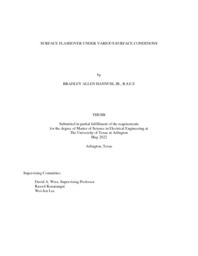
ATTENTION: The works hosted here are being migrated to a new repository that will consolidate resources, improve discoverability, and better show UTA's research impact on the global community. We will update authors as the migration progresses. Please see MavMatrix for more information.
Show simple item record
| dc.contributor.advisor | Wetz, David A | |
| dc.contributor.advisor | Schizas, Ioannis D | |
| dc.creator | Hannum, Bradley A | |
| dc.date.accessioned | 2022-06-28T15:11:49Z | |
| dc.date.available | 2022-06-28T15:11:49Z | |
| dc.date.created | 2022-05 | |
| dc.date.issued | 2022-05-12 | |
| dc.date.submitted | May 2022 | |
| dc.identifier.uri | http://hdl.handle.net/10106/30392 | |
| dc.description.abstract | Electrical insulators are critical components used in every high voltage application whether it is operated continuously or in a pulsed mode. Bulk dielectric breakdown and surface flashover must be prevented in all use cases, especially those that occur in polluted environments. Though electrical standards have been written as a guide to prevent insulator surface flashover, such as Underwriters Laboratories (UL) 840, they are not directly applicable to applications where size and weight are critical. UL 840 experimental design is vague, does not consider all environments, and is written primarily with the electric power utilities in mind. The research presented here is aimed at studying surface flashover under polluted environments for comparison to the advice given by UL 840 and other similar standards. The aim is to provide the electrical community with insight into how to use these standards when size and weight are critical and over conservativeness does not support operational needs. Five different insulator materials have been subjected to different pollution levels, and their dielectric flashover strength has been studied across samples of three different widths. Experiments have been performed under continuously applied DC electric fields and for those in which breakdown occurred below 12 kV, similar experiments have been performed under transiently applied electric fields for comparison. The experimental setup and the results obtained will be presented. | |
| dc.format.mimetype | application/pdf | |
| dc.language.iso | en_US | |
| dc.subject | Clearance | |
| dc.subject | Creepage | |
| dc.subject | Dielectric breakdown | |
| dc.subject | Insulator pollution | |
| dc.subject | Surface flashover | |
| dc.title | SURFACE FLASHOVER UNDER VARIOUS SURFACE CONDITIONS | |
| dc.type | Thesis | |
| dc.degree.department | Electrical Engineering | |
| dc.degree.name | Master of Science in Electrical Engineering | |
| dc.date.updated | 2022-06-28T15:11:50Z | |
| thesis.degree.department | Electrical Engineering | |
| thesis.degree.grantor | The University of Texas at Arlington | |
| thesis.degree.level | Masters | |
| thesis.degree.name | Master of Science in Electrical Engineering | |
| dc.type.material | text | |
Files in this item
- Name:
- HANNUM-THESIS-2022.pdf
- Size:
- 3.362Mb
- Format:
- PDF
This item appears in the following Collection(s)
Show simple item record


